Using SEBAL to Investigate How Variations in Climate Impact on Crop Evapotranspiration
Abstract
:1. Introduction
1.1. Climate and Climate Changes in Cyprus
1.2. Crop Water Requirements
- ▪
- Rn is the instantaneous net radiation (W∙m−2)
- ▪
- G is the instantaneous soil heat flux (W∙m−2)
- ▪
- H is the instantaneous sensible heat flux (W∙m−2)
- ▪
- λET is the instantaneous latent heat flux (W∙m−2)
2. Materials and Methods
- LAI = Leaf Area Index;
- WDVI = Weighted Difference Vegetation Index;
- α = complex combination of extinction and scattering coefficients; and
- ρ∞ = asymptotically limiting value of the WDVI at very high LAI values.
3. Results
4. Discussion
5. Conclusions
Acknowledgments
Author Contributions
Conflicts of Interest
References
- European Commission. Climate Change, Impacts and Vulnerability in Europe; An Indicator-Based Report, EEA Report No 12/2012; European Commission: Brussels, Belgium, 2012; ISSN 1725-9177. [Google Scholar]
- Cyprus Meteorological Service 2013. Monthly rainfall in Cyprus during the hydrometeorological year: 2008–2009 and 2009–2010. Available online: http://www.moa.gov.cy/moa/MS/MS.nsf/DMLmeteo_reports_en/DMLmeteo_reports_en?open (accessed on 7 July 2017).
- Zoumides, C.; Bruggeman, A. Temporal and Spatial Analysis of Blue and Green Water Demand for Crop Production in Cyprus; Water Development Department: Nicosia, Cyprus, 2010; Available online: http://www.cyi.ac.cy/node/698 (accessed on 7 July 2017).
- Vakakis and Associates. The Consequences of EU Accession and the Future of the Agricultural Sector in Cyprus; Department of Agriculture, Ministry of Agriculture, Natural Resources and the Environment: Nicosia, Cyprus, 2010. [Google Scholar]
- Markou, M.; Papadavid, G. Norm Input Output Data for the Main Crop and Livestock Enterprises of Cyprus; Agricultural Economics Report 46; Agricultural Research Institute of Cyprus: Nicosia, Cyprus, 2007; pp. 196–199. ISBN 0379-0827. [Google Scholar]
- Water Development Department (WDD). Cost Assessment & Pricing of Water Services in Cyprus. Summary. March 2010. Available online: http://www.moa.gov.cy/moa/wdd/Wdd.nsf/guide_en/guide_en? (accessed on 7 July 2017).
- Statistical Service. 2007–2009. Vine Statistics 2006–2008. Agricultural Statistics, Series II (Individual Reports for Each Year); Republic of Cyprus Printing Office: Nicosia, Cyprus, 2010.
- Rogers, J.S.; Allen, L.H., Jr.; Calvert, D.V. Evapotranspiration from a humid-region developing citrus grove with a grass cover. Trans. ASAE 1983, 26, 1778–1783. [Google Scholar] [CrossRef]
- Souch, C.; Wolfe, C.P.; Grimmond, C.S.B. Wetland evaporation and energy partitioning: Indiana Dunes National Lakeshore. J. Hydrol. 1996, 184, 189–208. [Google Scholar] [CrossRef]
- Pereira, L.S.; Perrier, A.; Allen, R.G.; Alves, I. Evapotranspiration: Concepts and future trends. J. Irrig. Drain. Eng. 1999, 125, 45–51. [Google Scholar] [CrossRef]
- Doorenbos, J.; Pruitt, W.O. Crop Water Requirements. Irrigation and Drainage Paper No. 24 (Revised); FAO Irrigation and Drainage Paper; FAO: Rome, Italy, 1977; p. 144. [Google Scholar]
- Allen, R.G.; Pereira, L.S.; Raes, D.; Smith, M. Crop Evapotranspiration—Guidelines for Computing Crop Water Requirements—FAO Irrigation and Drainage Paper 56; Food and Agriculture Organization of the United Nations (FAO): Rome, Italy, 1998; p. 300. [Google Scholar]
- D’Urso, G.; Menenti, M. Mapping crop coefficients in irrigated areas from Landsat TM images. Proc. SPIE 1995, 2585, 41–47. [Google Scholar]
- Bastiaanssen, W.G.M.; Noordman, E.J.M.; Pelgrum, H.; David, G.; Thoreson, B.P.; Allen, R.G. SEBAL model with remotely sensed data to improve water resources management under actual field conditions. ASCE J. Irrig. Drain. Eng. 2005, 131, 85–93. [Google Scholar] [CrossRef]
- Bastiaanssen, W.G.M.; Menenti, M.; Feddes, R.A.; Holtslag, A.A.M. A remote sensing surface energy balance algorithm for land (SEBAL), part 1: Formulation. J. Hydrol. 1998, 212–213, 198–212. [Google Scholar] [CrossRef]
- Bastiaanssen, W.G.M. SEBAL-based sensible and latent heat fluxes in the irrigated Gediz Basin, Turkey. J. Hydrol. 2000, 229, 87–100. [Google Scholar] [CrossRef]
- Alexandridis, T. Scale Effect on Determination of Hydrological and Vegetation Parameters Using Remote Sensing Techniques and GIS. Ph.D. Thesis, Aristotle University of Thessalonikh, Thessalonikh, Greece, 2003. [Google Scholar]
- Bandara, K.M.P.S. Assessing Irrigation per Formance by Using Remote Sensing. Ph.D. Thesis, Wageningen University, Wageningen, The Netherlands, 2006. [Google Scholar]
- Papadavid, G.; Hadjimitsis, D. Adaptation of SEBAL for estimating groundnuts evapotranspiration, in Cyprus. South-Eastern Eur. J. Earth Obs. Geomat. 2013, 1, 59–70. [Google Scholar]
- Morse, A.; Tatsumi, M.; Allen, R.G.; Kramber, W.G. Application of the SEBAL Methodology for Estimating Consumptive Use of Water and Stream Flow Depletion in the Bear River Basin of Idaho through Remote Sensing. EOSDIS Project Report; Raytheon Systems Company and the University of Idaho, USA, 2000. Available online: http://hydrology1.nmsu.edu/Teaching_Material/Agro500/SEBALFolder%20Tutor%20link%20and%20excel%20files/References/FinalAllenReport.pdf (accessed on 20 July 2017).
- Papadavid, G.; Hadjimitsis, D.G.; Toulios, L.; Michaelides, S. A Modified SEBAL Modeling Approach for Estimating Crop Evapotranspiration in Semi-arid Conditions. J. Water Resour. Manag. 2013, 27. [Google Scholar] [CrossRef]
- Alexandridis, T.K.; Cherif, I.; Chemin, Y.; Silleos, G.N.; Stavrinos, E.; Zalidis, G.C. Integrated Methodology for Estimating Water Use in Mediterranean Agricultural Areas. Remote Sens. 2009, 1, 445–465. [Google Scholar] [CrossRef]
- Alexandridis, T.K.; Panagopoulos, A.; Galanis, G.; Alexiou, I.; Cherif, I.; Chemin, Y. Combining remotely sensed surface energy fluxes and GIS analysis of groundwater parameters for irrigation system assessment. Irrig. Sci. 2014, 32, 127–140. [Google Scholar] [CrossRef]
- Yonggwan Lee and Seongjoon Kim. The Modified SEBAL for Mapping Daily Spatial Evapotranspiration of South Korea Using Three Flux Towers and Terra MODIS Data. Remote Sens. 2016, 8, 983. [Google Scholar] [CrossRef]
- Kustas, W.P.; Norman, J.M. A Two-Source Energy Balance Approach Using Directional Radiometric Temperature Observations for Sparse Canopy Covered Surfaces. Agron. J. 2000, 92, 847–854. [Google Scholar] [CrossRef]
- Papadavid, G.; Hadjimitsis, D.G. Spectral signature measurements during the whole life cycle of annual crops and sustainable irrigation management over Cyprus using remote sensing and spectro-radiometric data: The cases of spring potatoes and peas. Proc. SPIE 2009, 7472. [Google Scholar] [CrossRef]
- Pashiardis, M. Options for Sustainable Agricultural Production and Water Use in Cyprus under Global Change: Agroclimatic and Agro-Ecological Zones of Cyprus; Agwater Project Scientific Report 1; Cyprus Meteorological Service: Nicosia, Cyprus, 15 March 2013. [Google Scholar]
- Cherif, I.; Alexandridis, T.K.; Jauch, E.; Chambel-Leitao, P.; Almeida, C. Improving remotely sensed actual evapotranspiration estimation with raster meteorological data. Int. J. Remote Sens. 2015, 36, 4606–4620. [Google Scholar] [CrossRef]
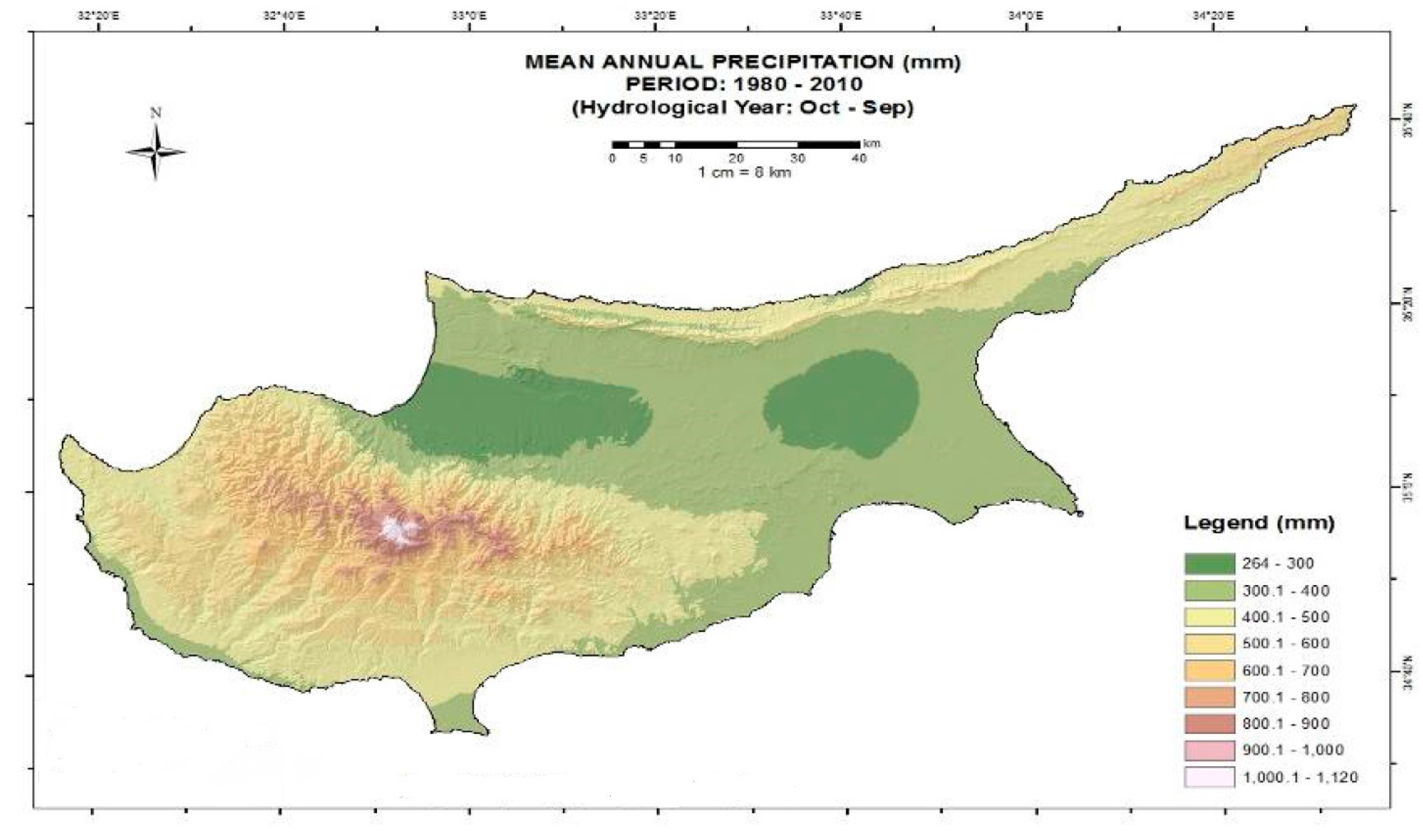
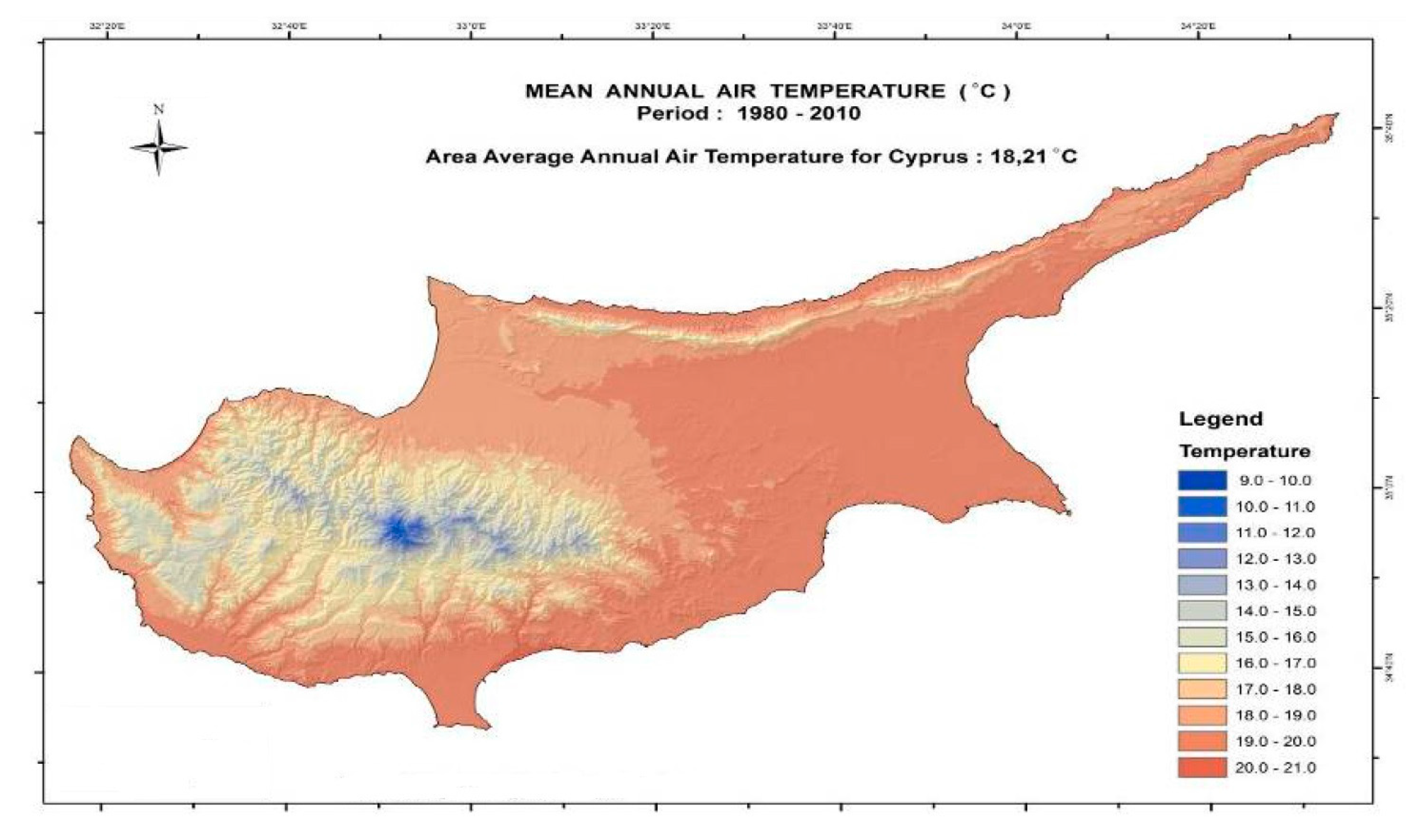
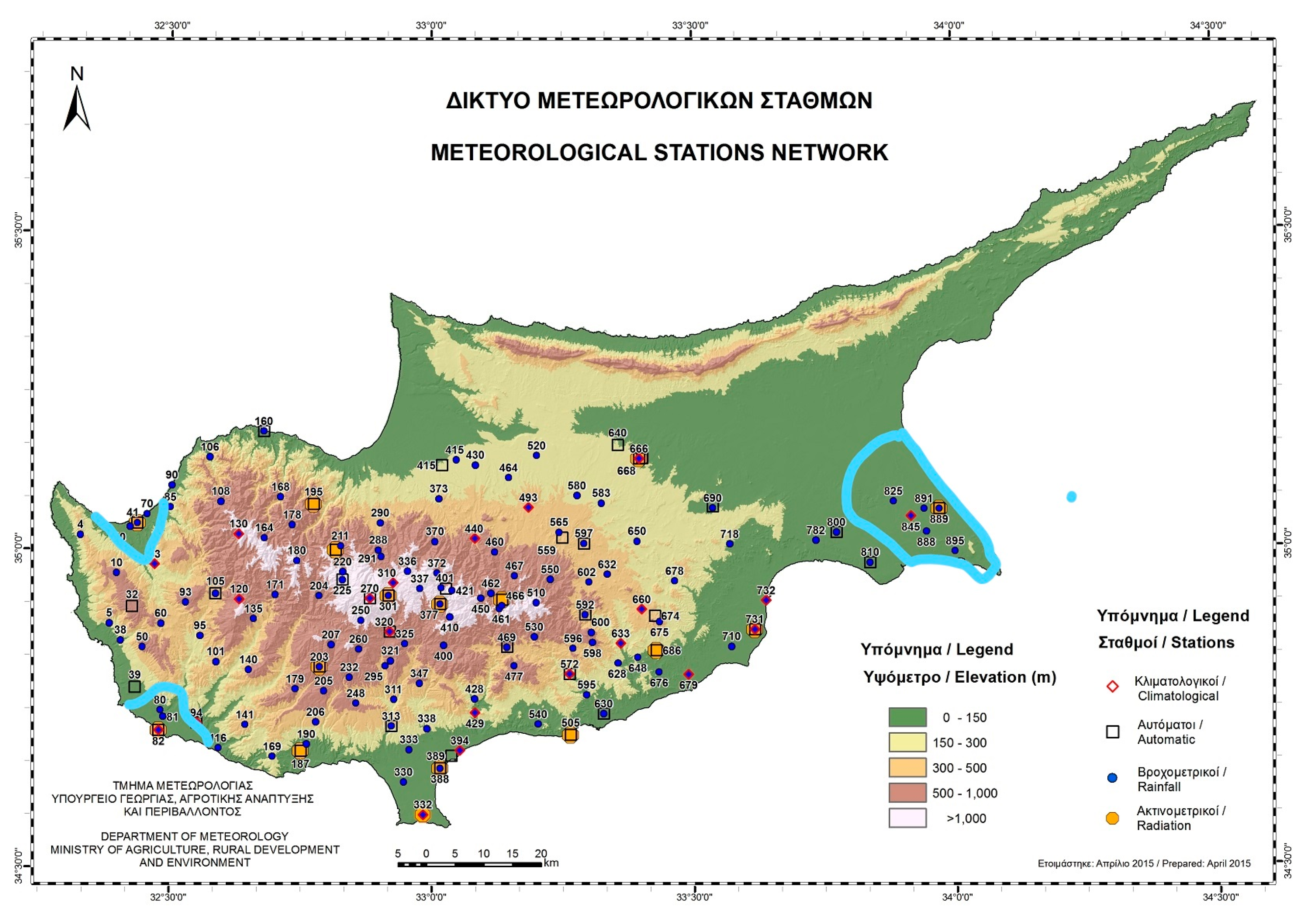
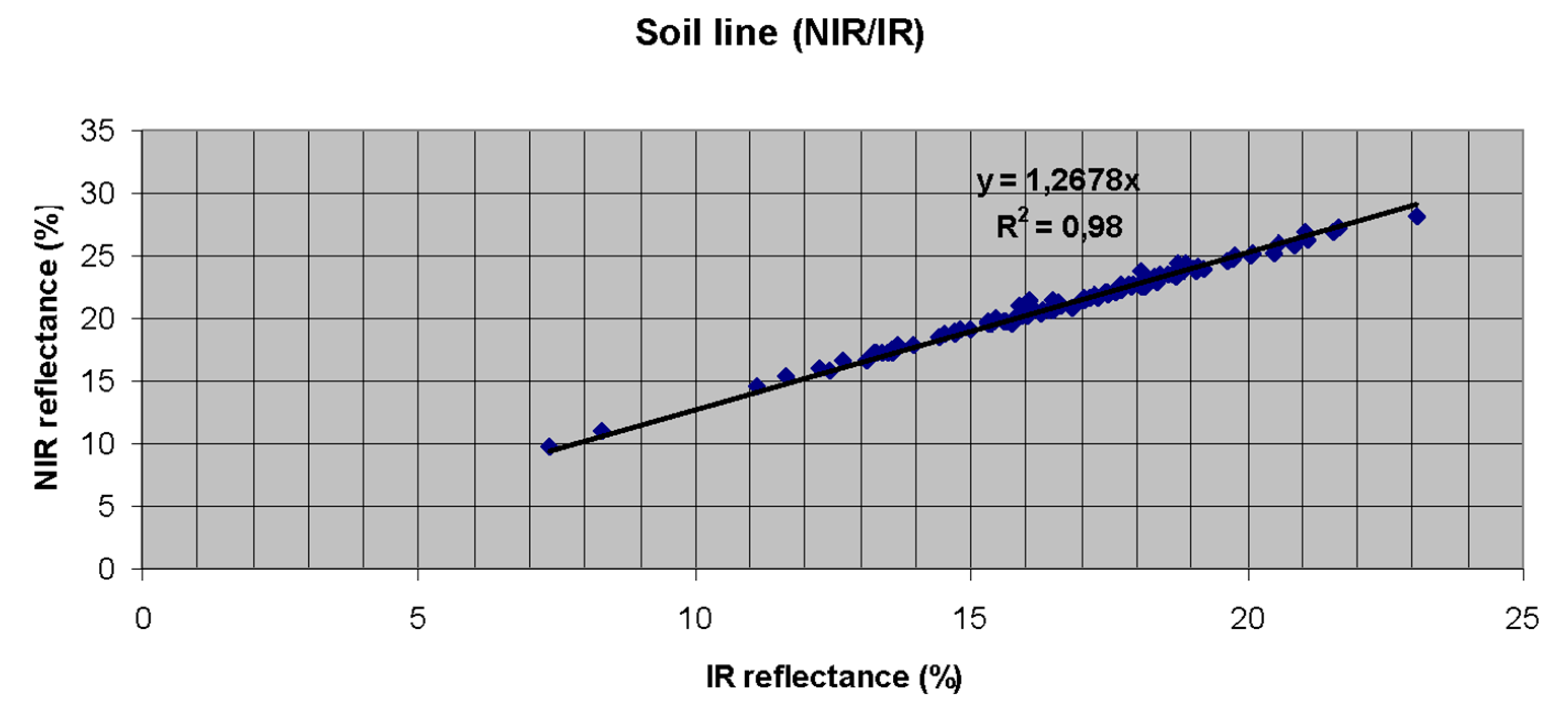
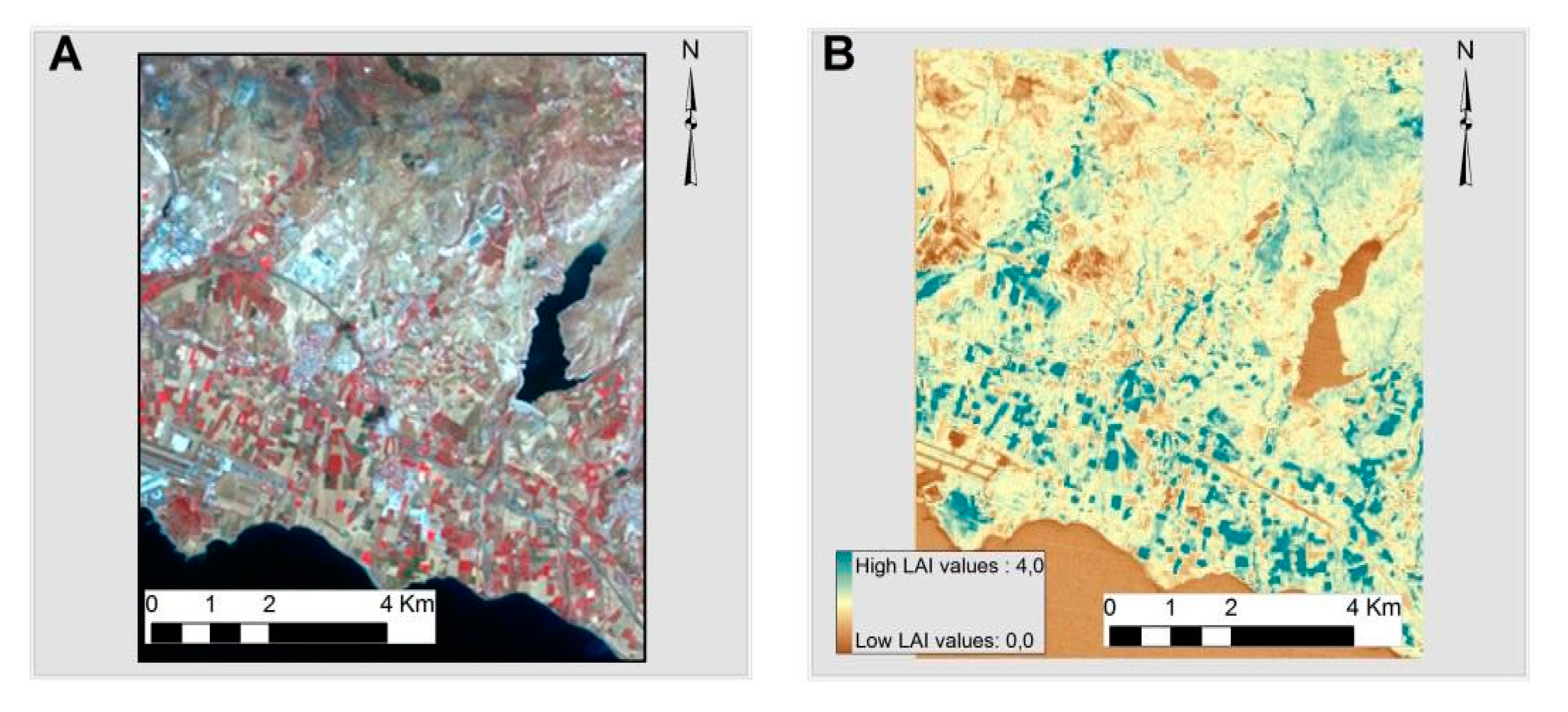

| Climate Change Indicators | Northern Europe | Central and Eastern Europe | Mediterranean |
|---|---|---|---|
| Direct losses from weather disasters | M(−) | M(−) | H(−) |
| River flooding disasters | M(−) | H(−) | L(−) |
| Coastal flooding | H(−) | M(−) | H(−) |
| Public water supply and drinking water | L(−) | L(−) | H(−) |
| Crop yields in agriculture | H(+) | M(−) | H(−) |
| Crop yields in forestry | M(+) | L(−) | H(−) |
| Biodiversity | M(+) | M(−) | H(−) |
| Energy for heating and cooling | M(+) | L(+) | M(−) |
| Hydropower and cooling for thermal plants | M(+) | M(−) | H(−) |
| Tourism and recreation | M(+) | L(+) | M(−) |
| Health | L(−) | M(−) | H(−) |
| Pafos | Citrus | Colocasi | Bananas | Spring Potatoes | Avocado | |||||
|---|---|---|---|---|---|---|---|---|---|---|
| ET Crop (mm) | ET Crop (mm) | ET Crop (mm) | ET Crop (mm) | ET Crop (mm) | ||||||
| Month | 1994–2004 | 2005–2015 | 1994–2004 | 2005–2015 | 1994–2004 | 2005–2015 | 1994–2004 | 2005–2015 | 1994–2004 | 2005–2015 |
| January | 0.0 | 0.0 | 0.0 | 0.0 | 0.0 | 0.0 | 0.0 | 0.0 | 0.0 | 0.0 |
| February | 0.0 | 0.0 | 0.0 | 0.0 | 0.0 | 0.0 | 0.0 | 0.0 | 0.0 | 0.0 |
| March | 0.0 | 0.0 | 41.4 | 49.3 | 0.0 | 0.0 | 67.8 | 80.9 | 0.0 | 0.0 |
| April | 74.8 | 83.0 | 184.1 | 204.5 | 82.1 | 91.1 | 110.4 | 122.6 | 79.9 | 82.9 |
| May | 118.4 | 129.5 | 225.9 | 247.1 | 141.3 | 154.6 | 155.5 | 170.1 | 136.4 | 137.6 |
| June | 142.4 | 154.7 | 415.3 | 451.3 | 191.5 | 208.0 | 0.0 | 0.0 | 155.3 | 161.8 |
| July | 145.9 | 157.9 | 482.8 | 522.6 | 236.5 | 256.0 | 0.0 | 0.0 | 153.9 | 160.8 |
| August | 188.9 | 203.1 | 495.3 | 532.6 | 254.3 | 273.4 | 0.0 | 0.0 | 206.1 | 213.0 |
| September | 140.5 | 147.5 | 439.7 | 461.5 | 235.2 | 246.8 | 0.0 | 0.0 | 152.5 | 154.6 |
| October | 68.0 | 76.1 | 202.0 | 226.1 | 163.0 | 182.5 | 0.0 | 0.0 | 72.7 | 75.5 |
| November | 12.8 | 14.6 | 182.8 | 208.1 | 66.7 | 75.9 | 0.0 | 0.0 | 12.5 | 13.2 |
| December | 0.0 | 0.0 | 0.0 | 0.0 | 0.0 | 0.0 | 0.0 | 0.0 | 0.0 | 0.0 |
| Total | 891.6 | 966.4 | 2669.3 | 2903.1 | 1370.5 | 1488.4 | 333.7 | 373.6 | 969.3 | 999.4 |
| Polis | Citrus | Colocasi | Bananas | Spring Potatoes | Avocado | |||||
|---|---|---|---|---|---|---|---|---|---|---|
| ET Crop (mm) | ET Crop (mm) | ET Crop (mm) | ET Crop (mm) | ET Crop (mm) | ||||||
| Month | 1994–2004 | 2005–2015 | 1994–2004 | 2005–2015 | 1994–2004 | 2005–2015 | 1994–2004 | 2005–2015 | 1994–2004 | 2005–2015 |
| January | 0.0 | 0.0 | 0.0 | 0.0 | 0.0 | 0.0 | 0.0 | 0.0 | 0.0 | 0.0 |
| February | 0.0 | 0.0 | 0.0 | 0.0 | 0.0 | 0.0 | 0.0 | 0.0 | 0.0 | 0.0 |
| March | 0.0 | 0.0 | 39.4 | 47.0 | 0.0 | 0.0 | 65.7 | 78.4 | 0.0 | 0.0 |
| April | 68.5 | 77.6 | 165.2 | 187.3 | 73.6 | 83.4 | 100.8 | 114.2 | 81.7 | 90.8 |
| May | 114.4 | 121.8 | 213.9 | 227.7 | 133.7 | 142.3 | 149.7 | 159.4 | 129.4 | 141.5 |
| June | 148.1 | 159.1 | 423.2 | 454.6 | 194.9 | 209.3 | 0.0 | 0.0 | 155.6 | 169.1 |
| July | 159.7 | 171.1 | 517.7 | 554.6 | 253.4 | 271.4 | 0.0 | 0.0 | 159.4 | 172.6 |
| August | 203.4 | 217.5 | 522.4 | 558.5 | 267.9 | 286.4 | 0.0 | 0.0 | 206.4 | 222.0 |
| September | 139.4 | 145.7 | 427.1 | 446.5 | 228.2 | 238.5 | 0.0 | 0.0 | 153.6 | 161.2 |
| October | 64.2 | 66.3 | 186.6 | 192.7 | 150.5 | 155.4 | 0.0 | 0.0 | 74.3 | 83.2 |
| November | 12.5 | 13.7 | 174.7 | 191.5 | 63.7 | 69.8 | 0.0 | 0.0 | 14.0 | 15.9 |
| December | 0.0 | 0.0 | 0.0 | 0.0 | 0.0 | 0.0 | 0.0 | 0.0 | 0.0 | 0.0 |
| Total | 910.2 | 972.8 | 2670.5 | 2860.5 | 1365.7 | 1456.5 | 316.2 | 352.0 | 974.5 | 1056.3 |
| Famagusta | Citrus | Colocasi | Bananas | Spring Potatoes | Avocado | |||||
|---|---|---|---|---|---|---|---|---|---|---|
| ET Crop (mm) | ET Crop (mm) | ET Crop (mm) | ET Crop (mm) | ET Crop (mm) | ||||||
| Month | 1994–2004 | 2005–2015 | 1994–2004 | 2005–2015 | 1994–2004 | 2005–2015 | 1994–2004 | 2005–2015 | 1994–2004 | 2005–2015 |
| January | 0.0 | 0.0 | 0.0 | 0.0 | 0.0 | 0.0 | 0.0 | 0.0 | 0.0 | 0.0 |
| February | 0.0 | 0.0 | 0.0 | 0.0 | 0.0 | 0.0 | 0.0 | 0.0 | 0.0 | 0.0 |
| March | 32.1 | 28.2 | 57.7 | 50.7 | 40.1 | 35.2 | 96.2 | 84.5 | 24.8 | 29.5 |
| April | 99.4 | 89.9 | 239.8 | 216.7 | 106.7 | 96.5 | 146.2 | 132.1 | 82.2 | 91.3 |
| May | 150.1 | 132.5 | 280.6 | 247.7 | 175.4 | 154.8 | 196.4 | 173.4 | 130.1 | 142.4 |
| June | 172.8 | 155.7 | 493.9 | 445.0 | 227.4 | 204.9 | 0.0 | 0.0 | 156.5 | 170.1 |
| July | 182.2 | 160.4 | 590.6 | 520.0 | 289.0 | 254.5 | 0.0 | 0.0 | 160.4 | 173.6 |
| August | 235.6 | 205.1 | 605..0 | 526.7 | 310.2 | 270.1 | 0.0 | 0.0 | 207.7 | 223.3 |
| September | 174.7 | 146.2 | 535.3 | 447.9 | 286.0 | 239.3 | 0.0 | 0.0 | 154.5 | 162.2 |
| October | 83.5 | 70.4 | 242.8 | 204.7 | 195.8 | 165.0 | 0.0 | 0.0 | 74.8 | 83.7 |
| November | 16.6 | 14.4 | 232.3 | 201.3 | 84.6 | 73.3 | 0.0 | 0.0 | 14.1 | 16.0 |
| December | 0.0 | 0.0 | 0.0 | 0.0 | 0.0 | 0.0 | 0.0 | 0.0 | 0.0 | 0.0 |
| Total | 1147.0 | 1002.7 | 3277.9 | 2860.7 | 1715.2 | 1493.6 | 438.8 | 390.1 | 1005.0 | 1092.1 |
| Paired Samples | Paired Differences | Tobserved at 0.95 conf. Level | Tstatist at 0.95 conf. Level | df | Sig. (2-tailed) | |||
|---|---|---|---|---|---|---|---|---|
| Mean | Std. Deviation | Std. Error Mean | ||||||
| Pair 1 | Citrus19942004–Citrus20052015 | 0.28 | 13.75 | 2.75 | 0.10 | ±2.064 | 24 | 0.92 |
| Pair 2 | colocasi19942004–colocasi20055015 | −0.25 | 37.83 | 7.28 | −0.03 | ±2.056 | 26 | 0.97 |
| Pair 3 | bananas19942004–bananas20052015 | 0.53 | 20.61 | 4.12 | 0.13 | ±2.064 | 24 | 0.90 |
| Pair 4 | potatoes19942004–potatoes20052015 | −2.99 | 14.80 | 4.93 | −0.61 | ±2.306 | 8 | 0.56 |
| Pair 5 | avocados19942004–avocados20052015 | 0.46 | 1.98 | 0.40 | 1.15 | ±2.064 | 24 | 0.26 |
© 2017 by the authors. Licensee MDPI, Basel, Switzerland. This article is an open access article distributed under the terms and conditions of the Creative Commons Attribution (CC BY) license (http://creativecommons.org/licenses/by/4.0/).
Share and Cite
Papadavid, G.; Neocleous, D.; Kountios, G.; Markou, M.; Michailidis, A.; Ragkos, A.; Hadjimitsis, D. Using SEBAL to Investigate How Variations in Climate Impact on Crop Evapotranspiration. J. Imaging 2017, 3, 30. https://doi.org/10.3390/jimaging3030030
Papadavid G, Neocleous D, Kountios G, Markou M, Michailidis A, Ragkos A, Hadjimitsis D. Using SEBAL to Investigate How Variations in Climate Impact on Crop Evapotranspiration. Journal of Imaging. 2017; 3(3):30. https://doi.org/10.3390/jimaging3030030
Chicago/Turabian StylePapadavid, Giorgos, Damianos Neocleous, Giorgos Kountios, Marinos Markou, Anastasios Michailidis, Athanasios Ragkos, and Diofantos Hadjimitsis. 2017. "Using SEBAL to Investigate How Variations in Climate Impact on Crop Evapotranspiration" Journal of Imaging 3, no. 3: 30. https://doi.org/10.3390/jimaging3030030











